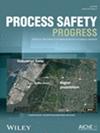A risk-based evaluation of safe distance for a hydrogen refueling station
IF 1
4区 工程技术
Q4 ENGINEERING, CHEMICAL
引用次数: 0
Abstract
To ensure the safety of hydrogen refueling stations (HRSs) and protective targets in the surrounding area, this paper has introduced a risk-based safe distance assessment method for a 35MP HRSs, emphasizing the impact of the station's surrounding area. The findings indicate that the safe distance is determined by vapor cloud explosion (VCE) accident scenarios arising from pipeline leaks (compressor-hydrogen storage tanks) at 125 m. Therefore, a crucial focus should be placed on safeguarding and maintaining hydrogen pipelines. Furthermore, based on societal risk, the requirement of a 358-m safe distance specifies that the population gathering within this range should be <500 people, virtually eliminating the possibility of constructing hydrogen stations in urban residential areas. Only in scenarios where VCE risks are not considered, less-populated surrounding environments might reduce the safe distance of hydrogen stations. Eliminating the risk scenarios of VCE is a crucial approach to lowering the safe distance of HRSs, making establishing such stations in urban centers feasible. Therefore, factors such as open spaces, well-ventilated facilities, and blast walls become critical elements in reducing the safe distance of HRSs.基于风险的加氢站安全距离评估
为确保加氢站(HRS)及周边防护目标的安全,本文针对 35MP 加氢站引入了基于风险的安全距离评估方法,强调了加氢站周边区域的影响。研究结果表明,安全距离是由 125 米处管道泄漏(压缩机-氢气储罐)引起的蒸汽云爆炸(VCE)事故情景决定的。因此,应重点关注氢气管道的保护和维护。此外,基于社会风险,358 米安全距离的要求规定,在此范围内聚集的人口应为 500 人,这实际上排除了在城市居民区建造氢气站的可能性。只有在不考虑 VCE 风险的情况下,人口较少的周边环境才有可能缩短氢站的安全距离。消除 VCE 风险情景是降低氢站安全距离的关键方法,使在城市中心建立氢站成为可行。因此,开放空间、通风良好的设施和防爆墙等因素成为缩短氢回收站安全距离的关键因素。
本文章由计算机程序翻译,如有差异,请以英文原文为准。
求助全文
约1分钟内获得全文
求助全文
来源期刊

Process Safety Progress
工程技术-工程:化工
CiteScore
2.20
自引率
10.00%
发文量
99
审稿时长
6-12 weeks
期刊介绍:
Process Safety Progress covers process safety for engineering professionals. It addresses such topics as incident investigations/case histories, hazardous chemicals management, hazardous leaks prevention, risk assessment, process hazards evaluation, industrial hygiene, fire and explosion analysis, preventive maintenance, vapor cloud dispersion, and regulatory compliance, training, education, and other areas in process safety and loss prevention, including emerging concerns like plant and/or process security. Papers from the annual Loss Prevention Symposium and other AIChE safety conferences are automatically considered for publication, but unsolicited papers, particularly those addressing process safety issues in emerging technologies and industries are encouraged and evaluated equally.
 求助内容:
求助内容: 应助结果提醒方式:
应助结果提醒方式:


